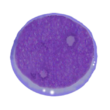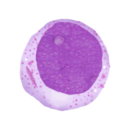The flow cytometric diagnosis of AML: Difference between revisions
From haematologyetc.co.uk
No edit summary |
No edit summary |
||
| Line 2: | Line 2: | ||
---- | ---- | ||
</br>''For most cases, the diagnosis of AML by flow cytometry is relatively straightforward. The problem lies in atypical cases and unusual diagnoses that may be missed.'' | </br>''For most cases, the diagnosis of AML by flow cytometry is relatively straightforward. The problem lies in atypical cases and unusual diagnoses that may be missed.'' | ||
'''1.''' '''The immunophenotype of AML blasts will (generally) reflect their primitive nature''' | <div style="width: 95%"> | ||
{| class="wikitable" style="border-style: solid; border-width: 5px; color:black" | |||
|colspan="1" style = "font-size:90%; color:black; background:#ddeee1"|'''1.''' '''The immunophenotype of AML blasts will (generally) reflect their primitive nature''' | |||
|- | |||
} | |||
[[Image:AML M1.png|110px]] | [[Image:AML M1.png|110px]] | ||
</br>''The typical "primitive" morphology of blast cells is generally accompanied by signs of primitive immunophenotype'' | </br>''The typical "primitive" morphology of blast cells is generally accompanied by signs of primitive immunophenotype'' | ||
Revision as of 13:15, 18 December 2023
For most cases, the diagnosis of AML by flow cytometry is relatively straightforward. The problem lies in atypical cases and unusual diagnoses that may be missed.
}

The typical "primitive" morphology of blast cells is generally accompanied by signs of primitive immunophenotype

The typical "primitive" morphology of blast cells is generally accompanied by signs of primitive immunophenotype
- Most often in AML typical features of immature cells will be found with: weak expression of CD45, together with expression of CD34 and/or CD117. Other markers may be useful in difficult cases (see Click for more detailed description)
- However in cases where blast cells show more differentiation their nature may be less clear. This is most frequently encountered in monocytic cases of AML or in APL (Click for a more detailed description)
2. The cases should express sufficient markers to allow myeloid lineage to be assigned

Like Auer rods or granulation in morphology, particular immunophenotypic features support assignment to myeloid lineage
- Typical cases can generally be recognised by their expression of combinations of myeloid markers of varying levels of specificity. These most often will include combinations of MPO, CD117, CD33 and CD13, although the relative specificity in AML diagnosis can vary and it is importat to ensure that criteria for myeloid-lineage assignment are met (see table for details)
- In cases with atypical maturation an extended marker panel may allow that differentiationto be identified, and may help to clarify myeloid lineage in difficult cases; however the specificity of these markers may be lower so care is required (see Table for details)
Are there atypical features?
- Expected abberency
- Feature that may give concern
| 1. The immunophenotype of AML blasts will (generally) reflect their primitive nature |